The dog training world has become exponentially more aware of the significance of dog body language communication over the past two decades. We know how critically important it is in keeping dogs and people safe, and in building relationships of mutual trust and respect that result in lifelong bonds between canines and their humans. And yet we still see training and behavior professionals as well as regular dog owners who utterly fail to understand what their dogs are desperately trying to say to them.
This would be unfortunate even if it meant only that dogs and humans didn’t have as close a relationship as they otherwise might. But it races beyond unfortunate all the way to tragic when the result of the miscommunication is the severing of the human-animal bond that keeps the dog in her happy home, serious injury to humans, or, all too often, the eventual euthanasia of the dog. This may be the result of a bite, or simply the lack of emotional connection that holds relationships together. If our species universally had a better understanding of what our dogs are trying to communicate to us, we would see many more dogs living long, happy lives in forever homes.
Speaking Dog Language
Dogs are primarily body language communicators. While they are certainly able to understand many of the words we speak to them, and capable of a range of vocalizations themselves (see “Ways to Stop a Dog from Whining,” May 2017, and “Why Dogs Bark and How to Stop Them“, March 2017), their first language is body talk.
For someone who is very experienced with dogs – or someone who just has good natural instincts about dog body language – canine communications are obvious and intuitive. But even people with very little experience with dogs can learn to “hear” what dogs are expressing with their ears, eyes, mouths, tails, and posture. And there is immense value in learning how to understand those communications; the ability to read and react appropriately to dog body language not only keeps you safe, it greatly enhances your relationship with your own dog, as well as others you may encounter.
One good way to begin your canine language studies is to pay attention to how dogs may use their body parts in varying ways to express different things.
Check out “Canine Body Language Danger Signs” for some different presentations of hostility in dogs.
Tail Communication
Tucked under: Appeasing, deferent or fearful
Low and still: Calm, relaxed
Low to medium carriage, gently waving: Relaxed, friendly
Low to medium carriage, fast wag: Appeasing or happy, friendly
High carriage, still/vibrating or fast wag: Tension, arousal, excitement; could be play arousal or aggression arousal (note that a wagging tail does not always mean a happy dog!)
Ear Signals
Pinned back: Appeasing, deferent or fearful
Back and relaxed: Calm, relaxed, friendly
Forward and relaxed: Aware, friendly
Pricked forward: Alert, excitement, arousal, assertive; could be play arousal or aggression arousal
Eye Expressions
Averted, no eye contact: Appeasing, deferent or fearful (avoidance); may be a subtle flick of the eyes, or may turn entire head away
Squinting, or eyes closed: Appeasing, happy greeting
Soft, direct eye contact: Calm, relaxed, friendly
Eyes open wide: Confident, assertive
Hard stare: Alert, excitement, arousal; could be play arousal or aggression arousal
Mouth Expressions
Lips pulled back: Appeasing or fearful (may also be lifted in “submissive grin” or “aggressive grin”)
Licking lips, yawning: Stressed, fearful, or tired
Lips relaxed: Calm, friendly
Lips puckered forward, may be lifted (snarl): Assertive, threat
Hair
Piloerection or “raised hackles” is a sign of arousal. While it can indicate aggression, dogs may also exhibit piloerection when they are fearful, uncertain, or engaged in excited play.
Body Posture
Behind vertical, lowered; hackles may be raised: Appeasing or fearful
Vertical, full height: Confident, relaxed
Ahead of vertical, standing tall; hackles may be raised: Assertive, alert, excitement, arousal, possibly play arousal or aggressive arousal
Shoulders lowered, hindquarters elevated: A play bow – clear invitation to play; dog sending a message that behavior that might otherwise look like aggression is intended in play
See this list with example images here.
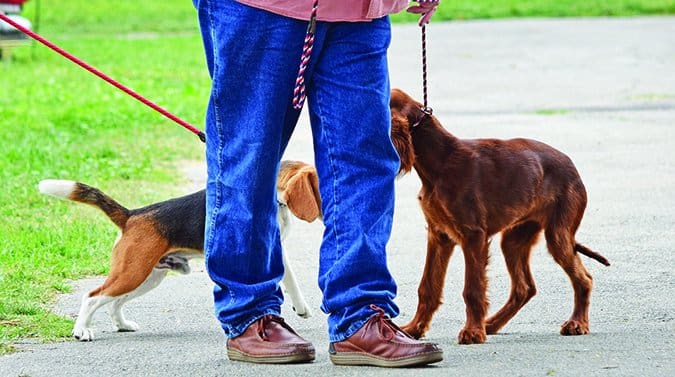
Note that many of the body language communications can have multiple meanings. The actual intent is determined by looking at the whole picture. A dog with her ears pricked forward and hackles raised accompanying a play bow is sending an entirely different message from the one with her ears pricked forward, hackles raised, standing tall and ahead of the vertical, giving a hard stare.
Once you’re good at reading canine body language, in a crisis, you will be able to quickly see the whole picture and respond appropriately, without having to take the time to analyze individual body parts.
Get some more detailed descriptions of dog communication signals by reading, “Your Dog’s Facial Expressions,” (March 2013).
In less urgent times, make a point of observing dog body language communications more thoughtfully, and respond appropriately – by greeting dogs who are clearly inviting interactions, and helping a dog who may show subtle signs of discomfort by not invading her comfort zone.
Human Body Language
Your ability to communicate appropriately back to your dog is every bit as important as your ability to read her communications. Making direct eye contact, bending forward from the waist, and reaching over the top of the head are some of the most common body language mistakes humans make with dogs.
Here are more appropriate ways to communicate your friendly intentions to the dog in front of you:
Eye Contact
In our culture, direct eye contact is admired. Someone who doesn’t look you in the eye is perceived as shifty, untruthful, or weak. Though there are other cultures where this is not true, in this part of the world, we humans regard making direct eye contact as the right and honorable way to greet other sentient beings.
In a dog’s world, however, direct eye contact is a challenge or a threat, while looking away is a sign of deference, appeasement, or respect. If you make direct eye contact with a dog and see signs of appeasement, fear, deference, or defensive or offensive aggression, you know this is a dog who is not comfortable with direct eye contact. Experienced handlers approach dogs with soft eye contact or without making eye contact at all.
That said, we make it a point to teach our own dogs that direct eye contact with a human is a highly rewarded behavior. Dog trainers from coast to coast go to great lengths to reinforce their dogs for making and maintaining eye contact.
When approaching a dog you don’t know, or if your own dog seems wary of you when you approach her, try looking off to the side or over her head instead of directly into her eyes. If she seems comfortable, try making brief, soft eye contact and see how she reacts. If her body language stays soft and she continues to approach you, she is probably comfortable with at least some eye contact. Take it slow.
Condition your dog to offer and value making eye contact with you by following the protocol in, “Teach Your Dog to Make Eye Contact.”
Hands
What’s the first thing you’re likely to do when you’re introduced to a human stranger? Reach out boldly and shake hands with a firm grip. What’s the first thing many humans are likely to do when they meet a dog? Reach out boldly and pat her on top of the head. Non-dog-savvy humans, that is. Many dogs hate being patted on top of the head, although some tolerate it; only a small minority may actually enjoy it.
If you want to make a good impression on the canines you meet, you might do best not to reach out at all. Rather, allow the dog to offer the first contact with you.
If you must reach toward a dog, offer your open hand, palm up, below her chin level, and let her reach forward to sniff. If she invites closer contact, try scratching gently under her chin or behind her ear – most dogs love that. Watch her response; she may not like touch, or she may not yet be ready for that much intimacy from a stranger. If she pulls away or shows signs of fear, appeasement, avoidance, or aggression, respect her message and stop trying to touch her.
Hugs
Even in the world of humans, you’d be offended if someone you didn’t know walked up and wrapped arms around you in an intimate hug. Lots of dogs are equally offended, even by hugs from someone they know well. Sure, there are dogs who invite hugs and snuggles, but they are the exception, not the rule.
Never try to hug a dog you don’t know (and don’t let your children do it, either!).
If you are in the habit of hugging (or allowing your children to hug) your own dog, video some hugs in action and take a good hard look at her body language. If your dog leans into the hugs with a relaxed body and soft expression, you’re on solid ground. In contrast, if you see your dog ducking, looking away, leaning away, tensing up, or offering other avoidance signals, you might want to rethink your hugging program.
If you’re dead set on hugging a dog who isn’t loving it, then make a commitment to a counter-conditioning program that can teach her to love – or at least calmly accept – hugs. Follow, “Train Your Dog to Accept Hugs,” to get started.

Body Orientation
Remember that approach for greeting another human and shaking her hand? You probably stood tall and offered a full-frontal presentation at the same time; we humans would think it quite weird if someone crouched and/or sidled up to us to say hello.
However, to a dog, a face-front direct approach along with direct eye contact screams, “Threat!” Equally offensive to many dogs is the human habit of bending or hovering over a dog. If you watch a dog professional making the acquaintance of a new canine friend, you are likely to see her kneel sideways while avoiding eye contact, either keeping her hands close to her body or offering an open hand low to the ground.
Take your lead from professional trainers and handlers. The more wary of you the dog appears, the more important it is for your to turn sideways and make yourself small and non-threatening. Of course, if you’re greeting an enthusiastic Labrador Retriever who is happily trying to body-slam you at the end of his leash, you’re probably safe to stand up and face front. But, still, no hugs, head-pats, or hovering, please.
Movement
Dogs, especially dogs who aren’t completely comfortable with humans, are very sensitive to our movement. Fast, sudden, and erratic movements can be alarming, especially if they are combined with direct eye contact and inappropriate hand-reaching. Slow, calm movement – or in some case no movement at all – is a better approach with a dog you don’t know.
Demeanor
Now here’s the tricky part. Often, when humans are trying to avoid eye contact, move slowly, speak softly, turn sideways, and control the movement of their hands, they end up looking tense and awkward. Or just plain weird. And that can be very alarming to a dog who isn’t sure about the approaching human – or humans in general.
To avoid this, video yourself with your own dog while you train yourself to control your eye contact, hands, and body postures. Practice until you can act natural while doing all the approach and greeting behaviors that feel very unnatural. Then ask your friends if you can try it with their dogs. Get really good at it before you try it with random dogs you meet in public. And always remember to ask the dog’s owner first for permission to greet – and respect their wishes if they hesitate or say no.
You obviously care about dogs; you are a Whole Dog Journal reader. Care enough about them to learn how to speak their language. Your dog is speaking to you all the time. Remember to listen with your eyes.
Author Pat Miller, CBCC-KA, CPDT-KA, is WDJ’s Training Editor. She and her husband Paul live in Fairplay, Maryland, site of her Peaceable Paws training center. Miller is also the author of many books on positive training. Her newest is Beware of the Dog: Positive Solutions for Aggressive Behavior in Dogs.



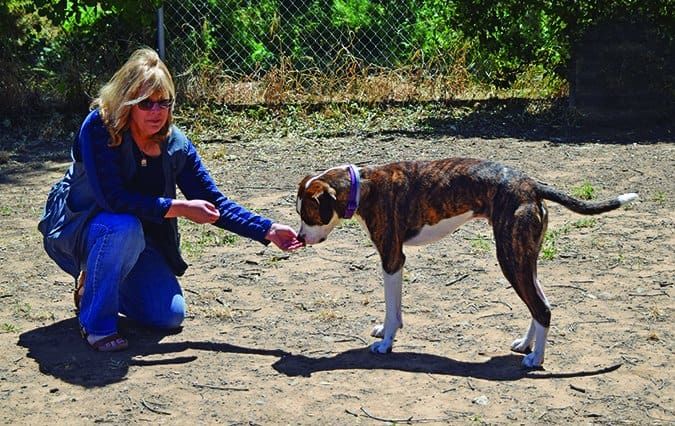
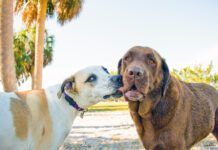
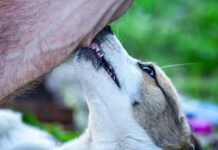
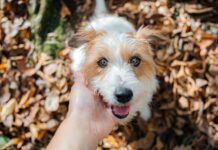
Congratulations on the new site!
FYI, this link from this story is still bad:
“See this list with example images here.”